“They enjoy a huge reverence in the prison system; they’re like little gods.”
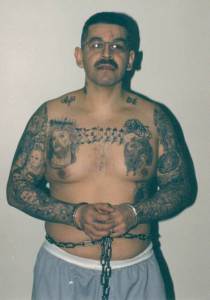
Not A God -- Mexican Mafia Gangster Frank "Puppet" Martinez
This is how the Mexican Mafia prison gang (“EME”) was described by retired Los Angeles County Sheriff’s Department gang sergeant Richard Valdemar on a recent NPR program.
It reminded me of one of my favorite quotes, from U.S. Attorney Patrick Fitzgerald in Chicago upon the taking down of a rat’s nest of Latin Kings a few years ago: “It may seem pretty cool to be a Supreme Inca when you’re the leader on the street of gang until the title ‘Supreme Inca’ becomes ‘lead defendant.'”

Bruce Riordan (Photo by Mandalit del Barco, NPR)
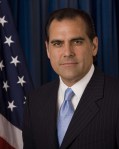
Rocky Delgadillo (LA City photo)
A couple of gangbusters in Los Angeles — city attorney Rocky Delgadillo and his anti-gang director, former federal prosecutor Bruce Riordan — are taking it to the next level. The pair are not content to just kick in gang heaven’s gate and jail deified gangsters. They’re going after the gangsters’ gold. An innovative civil law suit the team filed — based on a new California state law — targets two of the worst of LA’s transnational spawn, the Mexican Mafia and the 18th Street gang. The city wants the courts to take the gangs’ assets and distribute them among the neighborhoods ravaged by the criminals’ depredations. An interesting and useful twist is that the city does not have to prove that the gang assets in question came directly from its criminal operations. The theory of the state law and the case is based on common law nuisance — the gang has in effect deeply polluted a neighborhood and it must pay for the cleanup with its assets, however gotten.
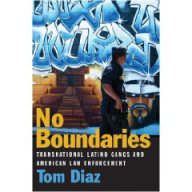
“Tom Diaz has worn out some shoe leather—much like a good detective—in gathering facts, not myths or urban legend. “
—Chris Swecker, Former Assistant Director of the FBI’s Criminal Investigative Division.
“Few people know more about the subject than Tom Diaz and no single book tells the whole story better than No Boundaries. If you really want to know what organized crime in America looks like today, then read this alarming book.”
—Rocky Delgadillo, former City Attorney of Los Angeles
Order No Boundaries from
[Update: Los Angeles has won its first anti-gang money damages lawsuit, against a different gang, as reported by the Christian Science Monitor:
The city of Los Angeles, plagued by 23,000 violent gang crimes since 2004, including 784 murders and 12,000 felony assaults, announced Tuesday that it had won its first civil judgment, for $5 million, against a criminal gang that had dominated the heroin trade downtown for decades….”By giving prosecutors more tools to fight gang activity at the local level, we are protecting our communities at the same time [that] we’re able to strengthen our statewide anti-gang efforts,” said Gov. Arnold Schwarzenegger in a statement released with the announcement of the $5 million verdict against the 5th and Hill gang in L.A.]
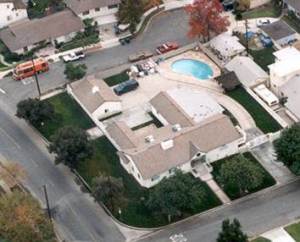
EME Gangster's Godfather-like Compound -- Not Your Stereotypical Barrio Dwelling
This reverse Robin Hood calls to mind the success of Morris Dees and the Southern Poverty Law Center in suing hate groups like the Ku Klux Klan for big bucks. Dees was a trail-blazer in using textbook tort law on behalf of hate crime victims to both win compensation and consequently shut down some of the most virulent haters in America. The assets of these gangs are mind-boggling. FBI agents found almost half-a-million dollars in cash inside a card-board box in one raid. The EME king-pin in that case lived in a compound straight outta The Godfather.
An early civil law innovation was the use of injunctions against gangs. The LA gang map is carved up with injunctions that limit the ability of diverse gangsters to operate in specific territories. But the gangs are so well-entrenched, and so organic in their adaptability, it’s hard to say how successful these injunctions have been. Proponents say their use has reduced gang violence. Opponents say the opposite. Let’s put it this way: according to latest reports, the gangs are still there.
Civil libertarians have complained about the civil rights of the those affected by injunctions.
“When a person who has not been convicted of any gang-related activity or any criminal activity, for that person to be prohibited from being on a public sidewalk during daylight hours, runs against everything that our Constitution stands for,” says Robin Toma, consultant and attorney at the Los Angeles County Human Relations Commission.
They are said to be unfairly “profiled.” Others claim the injunctions “divide” communities. We might expect similar opposition in this case.
“If Delgadillo’s lawsuit is a gimmick, filed to get a little media attention and soon forgotten, we don’t need it,” the Los Angeles Times wrote in an on-the-one hand, on-the-other hand editorial — praising the move so long as it works, but leaving room to criticize if it doesn’t.
The person who inked those skeptical words must never have meet Bruce Riordan. He is a determined man. It is a serious mistake to misjudge his grit, commitment, and legal acumen. In fact, the factual foundations of the present case go back more than a decade to the day when FBI Special Agent Carl Sandford walked into Assistant United States Attorney Riordan’s office. This was shortly after the federal government decided that criminal street gangs were no longer strictly a problem for local law enforcement — a pivotal part of the fallout from the 1992 Rodney King LA Riot. Latino and black gangs were key factors in the riot’s explosion and spread.
I relate the story of the 18th Street gang’s rise, the criminal operations of the Columbia Lil Cycos clique (CLC), the Mexican Mafia’s takeover of the drug “tax” (i.e., extortion) business, and the federal investigation and prosecution in a chapter of my forthcoming book, No Boundaries: Transnational Latino Gangs and Federal Law Enforcement (University of Michigan Press 2009).
Riordan, an eager young prosecutor, lobbied for and was assigned the task of investigating the 18th Street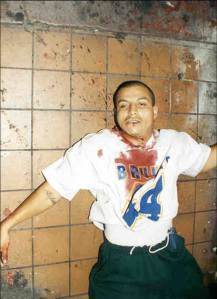
- 18th Street “Shot Caller” Lefty Cazales Was Killed by His “Homies” When He Crossed Janie (“Mom”) Garcia
gang. The complete file handed him consisted of one sheet of paper. He was breaking new ground in the federal prosecutor’s office. But he was initially thwarted by a series of indifferent, clock-punching investigators assigned to him by the FBI. That changed dramatically when Sandford walked in the door. The two hit it off famously.
Riordan and Sandford both had to wrestle with the skepticism, and sometimes downright hostility, of their respective front office management. “Bruce was fighting his demons, and I was fighting mine,” Sandford told me in an interview. “And we were both fighting the bad guys.” The old bulls in the U.S. Attorney’s organized crime section dismissed gangs as mere “street crime.” The FBI field office management did not yet understand that the gangs were unlike anything the agency had tangled with before. In a sense, both men were dealing with separate realities — the one they saw on the ground, and the preconceptions of their bosses.
Nevertheless, within a few years Bruce Riordan successfully prosecuted the CLC and EME — first RICO case against a Southern California street gang. With the help of the Los Angeles Police Department and other agencies, led by an enthusiastic FBI team that included agents Jim Wines and Tib Aguilar, among others, Riordan and Sandford proved that the Columbia Lil’ Cycos clique of the 18th Street gang, under the control of the Mexican Mafia prison gang, were running a classic organized crime operation, based largely on extortion of drug dealers and using ruthless armed violence to protect the scheme.
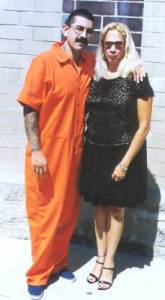
Gangster Underlings Called Frank Martinez and Janie Garcia "Dad" and "Mom" -- Not Leave it to Beaver Type People
Mexican Mafia member Frank “Puppet” Martinez ran the racketeering out of a prison cell, relying on his wife, Janie Garcia, as his trusted surrogate and field commander.
This all took place during a pivotal period in the history of Southern California’s Latino gangs. The 18th Street clica developed and refined the concept of extorting drug dealers with “renta,” or taxes. The Mexican Mafia thought it was such a good idea, they moved in, took over the direction and ordered all the Southern California Latino gangs to fall into line with the scheme. EME commanded gang shot-callers to attend a series of meetings, at which among other things they were told to stop drive-by shootings. But EME wasn’t trying to stop the killing. It just wanted to lower the profile while it consolidated the hugely profitable extortion business.
The investigation that Riordan and Sandford started continues to bear fruit. A series of federal RICO cases were developed on the foundation they laid. And the civil litigation Delgadillo and Riordan filed is built to a large extent on facts developed in the course of these cases.
Unfortunately, the task is huge and as a nation, we are falling behind. The continuing integration of Latino prison and street gangs into the operations of the Mexican drug trafficking cartels is making both the cartels and the gangs more dangerous every day. These organizations will not give up their multi-billion dollar cash cow without an all-out fight against them, using every tool we can think of.
It is starting to dawn on U.S. journalists and “opinion leaders” that Mexico is in a real war with the DTOs.
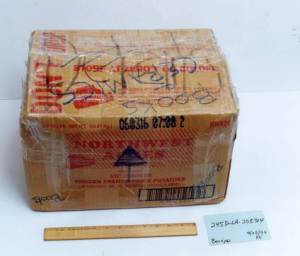
Half a Million Dollars in Cash Was Hidden in this Box
Nothing less than the existence of democratic governance on our southern border is at stake. However, it is not yet widely understood in the United States that EME, 18th Street, MS-13, and many other Latino gangs are combat soldiers in another front in the Mexican Drug War. That front is inside the U.S. — our law enforcement is facing heavily armed drug muscle. Drug trafficking violence and the Mexican Drug War’s battles are lapping over the border. As yet, the violence on our side of the border is less intense than the horrific butchery going on in Mexico. But some believe that it is not a question of whether, but when, we will see shocking incidents of urban warfare-type combat between our cops and the narcotraficantes, as well as gruesome civilian “collateral damage.” (For a sobering overview of the issue, see Gary “Rusty” Fleming’s new book, . He has also produced a documentary on the subject.)